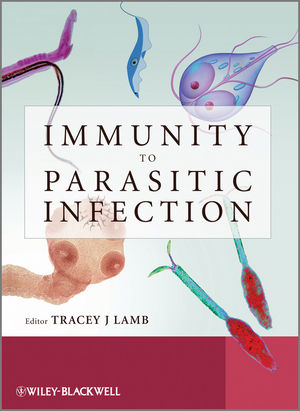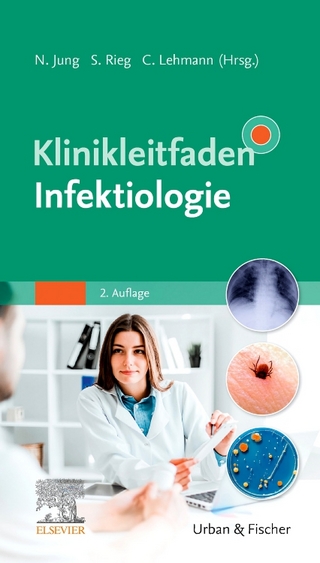
Immunity to Parasitic Infection
Wiley-Blackwell (Verlag)
978-0-470-97248-9 (ISBN)
For easy reference, the most commonly studied parasites are examined in individual chapters written by investigators at the forefront of their field. An overview of the immune system, as well as introductions to protozoan and helminth parasites, is included to guide background reading. A historical perspective of the field of immunoparasitology acknowledges the contributions of investigators who have been instrumental in developing this field of research.
Tracey Lamb is the editor of Immunity to Parasitic Infection, published by Wiley.
List of Contributors xiii Introduction: Immunoparasitology: The Making of a Modern Immunological science 1
Alan Sher
Section 1
1 Notes on the Immune System 15
Tracey J. Lamb
1.1 The immune system 15
1.2 Innate immune processes 17
1.3 The complement cascade 19
1.4 Innate recognition 20
1.5 Pattern recognition receptors 21
1.6 Innate immune cells 23
1.7 Communication in the immune system 31
1.8 Adaptive immunity 31
1.9 The role of theMHC in the immune response 34
1.10 T cell activation and cellular-mediated immunity 36
1.11 B cells and the humoral response 43
1.12 Cell trafficking around the body 49
1.13 Cellular immune effector mechanisms 50
1.14 Hypersensitivity reactions 52
References for further reading 54
Section 2
2 Introduction to Protozoan Infections 61
David B. Guiliano and Tracey J. Lamb
2.1 The protozoa 61
2.2 Amoebozoa 62
2.3 Excavata 67
2.4 Harosa 75
2.5 Protozoa that are now fungi 81
2.6 Taxonomy and the evolution of the parasitic protozoa 82
2.7 Genomic and post genomic exploration of protozoan biology 83
2.8 Summary 87
2.9 General information on protozoa 88
References for further reading 88
3 Apicomplexa:Malaria 91
Tracey J. Lamb and Francis M. Ndung’u
3.1 Malaria 91
3.2 Recognition ofmalaria parasites 94
3.3 Innate effector mechanisms 95
3.4 Adaptive immunity 98
3.5 Memory responses 101
3.6 Immune evasion 101
3.7 Immunopathology 103
References for further reading 105
4 Apicomplexa: Toxoplasma gondii 107
EmmaWilson
4.1 Introduction 107
4.2 Life cycle and pathogenesis 107
4.3 Innate immune responses 111
4.4 Evasion strategies 113
4.5 Adaptive immune responses 115
4.6 CNS infection 117
4.7 Conclusions 118
References for further reading 118
5 Apicomplexa: Cryptosporidium 121
Jan R. Mead andMichael J. Arrowood
5.1 Life cycle 122
5.2 Clinical presentation 123
5.3 General immune responses in cryptosporidiosis 124
5.4 Innate effector mechanisms 125
5.5 Adaptive immunity 127
5.6 Memory responses 131
5.7 Antigens eliciting the immune response 132
5.8 Immune evasion 132
5.9 Immunopathology in the gut and intestinal tract 134
References for further reading 134
6 Diplomonadida: Giardia 139
Steven Singer
6.1 The life cycle and pathogenesis of Giardia infection 139
6.2 Recognition of Giardia by the immune system 141
6.3 Innate effector mechanisms against Giardia 142
6.4 Adaptive immunity against Giardia 143
6.5 Memory responses 145
6.6 Antigens eliciting the immune response 146
6.7 Immune evasion 147
6.8 Immunopathology 148
6.9 Summary 150
References for further reading 150
7 Kinetoplastids: Leishmania 153
IngridM¨ uller and Pascale Kropf
7.1 The pathogenesis of Leishmania infection 153
7.2 Life cycle 154
7.3 Parasite transmission and avoidance of immune responses 155
7.4 Innate effector mechanisms: the role of neutrophils in Leishmania infection 157
7.5 Adaptive immunity: lessons from L. major infections of mice 158
7.6 Arginase promotes Leishmania parasite growth 162
7.7 Memory responses 163
References for further reading 164
8 Kinetoplastids: Trypanosomes 165
Jeremy Sternberg
8.1 The African trypanosomes (Trypanosoma brucei ssp.) 165
8.2 Pathogenesis of sleeping sickness 167
8.3 Variant surface glycoprotein – the key to trypanosome-host interactions 168
8.4 The humoral response to African trypanosomes 172
8.5 T cell responses in African trypanosome infections 173
8.6 Innate defence mechanisms: trypanosome lytic factor 173
8.7 Immunopathology and VSG 174
8.8 Summary 175
References for further reading 176
9 Kinetoplastids: Trypanosoma cruzi (Chagas disease) 179
Rick Tarleton
9.1 Life cycle and transmission 180
9.2 Immune control and disease 181
9.3 Innate recognition of T. cruzi 182
9.4 Adaptive immunity 183
9.5 Regulation of immune responses and parasite persistence 186
9.6 Conclusions 189
References for further reading 189
Section 3
10 Introduction to Helminth Infections 195
David B. Guiliano
10.1 Acanthocephala 196
10.2 Nematodes 196
10.3 Pentastomida 203
10.4 Platyhelminthes 203
10.5 The evolution of parasitism within the helminths: divergent phyla with common themes 208
10.6 Genomic and post-genomic exploration of helminth biology 211
10.7 Summary 211
References for further reading 213
11 Nematoda: Filarial Nematodes 217
Sabine Specht and Achim Hoerauf
11.1 The life cycle and pathogenesis of filarial nematode infections 217
11.2 Animal models of filariasis 220
11.3 Immune responsesmounted against filarial nematodes 221
11.4 Innate immunity 221
11.5 Adaptive immunity 224
11.6 Immune evasion 225
11.7 Immunopathology 228
References for further reading 229
12 Nematoda: Ascaris lumbricoides 231
Christina Dold
12.1 Introduction 231
12.2 Ascaris infection displays an over-dispersed frequency distribution 232
12.3 Life cycle 232
12.4 Pathogenesis of infection 233
12.5 Animal models of Ascaris infection 234
12.6 Immune responses generated against the migratory phase of Ascaris 235
12.7 The cytokine response to Ascaris lumbricoides 237
12.8 The humoral response to Ascaris lumbricoides 238
12.9 Antigens eliciting immune responses in Ascaris infection 241
12.10 Conclusions 242
References for further reading 243
13 Nematoda: Hookworms 247
Soraya Gaze, HenryMcSorley and Alex Loukas
13.1 Pathogenesis of hookworminfection 247
13.2 The life cycle of hookworms 248
13.3 Animal models of hookworminfection 249
13.4 Innate immune responses to hookworms 251
13.5 Adaptive immunity 252
13.6 Cytokine responses 253
13.7 Antibody responses 254
13.8 Antigens eliciting the immune response 255
13.9 Memory responses 255
13.10 Immunoregulatory aspects of the anti-hookwormimmune response 256
13.11 Conclusion 258
References for further reading 259
14 Nematoda: Trichuris 263
Colby Zaph
14.1 Trichuris infection 263
14.2 Life cycle and pathogenesis 264
14.3 Immunity to Trichuris 265
14.4 Recognition by the immune system 265
14.5 Innate immune responses 265
14.6 Adaptive immune responses 269
14.7 Immune memory 269
14.8 Vaccines 270
14.9 Trichuris as a therapeutic 270
14.10 Summary 271
References for further reading 271
15 Nematoda: Trichinella 275
Judith A. Appleton, Lisa K. Blum and Nebiat G. Gebreselassie
15.1 Life cycle 275
15.2 Pathogenesis 277
15.3 Adaptive immunity 278
15.4 Immunopathology 282
15.5 Evasion strategies 283
References for further reading 284
16 Trematoda: Schistosomes 287
Mark Wilson
16.1 The schistosome life cycle 287
16.2 Immunological recognition of schistosomes 290
16.3 Innate effector mechanisms 291
16.4 Adaptive immunity 292
16.5 Memory responses 297
16.6 Schistosome antigens eliciting immune responses 298
16.7 Immune evasion 298
16.8 Schistosomiasis and immunopathology 299
References for further reading 303
17 Cestoda: Tapeworm Infection 307
C´esar A. Terrazas,Miriam Rodr´ýguez-Sosa and Luis I. Terrazas
17.1 The life cycle of tapeworms 307
17.2 Epidemiology 309
17.3 Pathology 310
17.4 Innate immunity 311
17.5 Adaptive immunity 312
17.6 Antigens eliciting the immune responses 315
17.7 Immunomodulation or evasivemechanisms 316
17.8 Echinococcosis 316
17.9 Conclusions 320
References for further reading 320
Section 4
18 Co-infection: Immunological Considerations 325
Joanne Lello
18.1 Co-infection is the rule rather than the exception 325
18.2 Interactions between co-infecting parasites 326
18.3 The Th1/Th2 paradigm in co-infection 327
18.4 Co-infection can alter disease severity 328
18.5 Modelling parasite interactions during co-infection 329
18.6 Co-infection as a therapy? 330
18.7 Consideration of co-infection in an ecological framework 331
18.8 Concluding remarks 332
References for further reading 333
19 HIV and Malaria Co-infection 335
Aubrey Cunnington and EleanorM. Riley
19.1 The endemicity of HIV and malaria 335
19.2 HIV infection 335
19.3 Immunopathogenesis of HIV 341
19.4 Interactions between malaria and HIV 343
19.5 Effect of co-infection on treatment of HIV and malaria infections 347
19.6 Combined effects of HIV and malaria on susceptibility to other diseases 348
19.7 Malaria and HIV vaccines 349
19.8 Summary 351
References for further reading 351
20 HIV and Leishmania Co-infection 353
JavierMoreno
20.1 Leishmania parasitaemia is increased in HIV-Leishmania co-infection 354
20.2 Leishmania infection increases viral replication rate 354
20.3 Cell specific interactions between HIV-1 and Leishmania 355
20.4 Immune response interactions between HIV-1 and Leishmania 357
20.5 Immune reconstitution inflammatory syndrome in HIV-1/Leishmania co-infection 358
References for further reading 359
21 Gastrointestinal Nematodes and Malaria 361
Mathieu Nacher
21.1 Introduction 361
21.2 Results from field studies in humans are conflicting 361
21.3 Immune responses in GI nematode and malaria co-infections 363
21.4 Stereotypical but different 370
21.5 Animal models of GI nematode-malaria co-infection 370
21.6 Conclusions 372
References for further reading 372
22 Malaria and Schistosomes 375
ShonaWilson and Jamal Khalife
22.1 The epidemiology of schistosomiasis and malaria co-infection 375
22.2 Study design for malaria/schistosome co-infection studies 376
22.3 Antibody responses 380
22.4 Cytokine responses 382
22.5 Contribution of experimental models to the understanding of Schistosoma mansoni and Plasmodium co-infection 384
22.6 Conclusions 385
References for further reading 385
Section 5
23 Hygiene and Other Early Childhood Influences on the Subsequent Function of the Immune System 391
Graham A.W. Rook
23.1 Introduction 392
23.2 The Hygiene Hypothesis (or ‘Old Friends’ hypothesis) 392
23.3 Epidemiological transitions 393
23.4 Compensatory genetic variants 394
23.5 The critical organisms and their immunological role 395
23.6 Helminth infections and allergic disorders 395
23.7 Helminths and non-allergic chronic inflammatory disorders: human data 396
23.8 Animal models of helminth infection used to test the Hygiene Hypothesis 397
23.9 Non-helminthic ‘Old Friends’ 397
23.10 Mechanisms of immunoregulation 398
23.11 Conclusions 399
References for further reading 400
24 Nematodes as Therapeutic Organisms 401
William Harnett andMargaretM. Harnett
24.1 Evidence that parasitic nematodes can protect humans from allergy and autoimmunity 401
24.2 Mechanism of action 404
24.3 Nematodemolecules involved in preventing allergic/autoimmune disease 408
24.4 Clinical aspects 412
References for further reading 413
25.1 Vaccination AgainstMalaria 417
AlbertoMoreno
25.1.1 Malaria vaccines: proof of concept 417
25.1.2 Vaccine development 419
25.1.3 Pre-erythrocytic vaccines 420
25.1.4 Erythrocytic vaccines 423
25.1.5 Transmission-blocking vaccines 425
25.1.6 Whole organism vaccines 426
25.1.7 P. vivax vaccines 427
25.1.8 Concluding remarks 429
References for further reading 429
25.2 Current Approaches to the Development of a Vaccine Against Leishmaniasis 431
Yasuyuki Goto and Steven G. Reed
25.2.1 Vaccination against leishmaniasis 432
25.2.2 Anti-amastigote vaccines 432
25.2.3 Anti-saliva vaccines 436
25.2.4 Transmission prevention vaccines 436
25.2.5 Role of an adjuvant in vaccine development 436
25.2.6 Future directions 438
References for further reading 438
25.3 Vaccination Against Hookworms 441
Brent Schneider,Maria Victoria Periago and Jeffrey M. Bethony
25.3.1 The need for a vaccine 441
25.3.2 The Human HookwormVaccine Initiative 442
25.3.3 The history of hookwormvaccines: experiments in dogs 443
25.3.4 Antibody production against canine hookworm 443
25.3.5 Vaccination against hookwormwith irradiated larvae 444
25.3.6 Lessons from vaccination with irradiated larvae 445
25.3.7 Research identifying target proteins for an anti-hookwormvaccine 446
25.3.8 A human hookwormvaccine phase 1 clinical trial based on Na-ASP2 453
25.3.9 The HHVI takes a different approach 454
25.3.10 Developments through the last century and the future 455
References for further reading 456
25.4 Current Approaches to the Development of a Vaccine Against Filarial Nematodes 459
Sara Lustigman
25.4.1 Introduction to anti-filarial nematode vaccines 459
25.4.2 Anti-O. volvulus and anti-LF vaccines are a valid approach to advance control measures against onchocerciasis and lymphatic filariasis 461
25.4.3 Future directions for vaccine development 466
25.4.4 Discovery of new vaccine candidates 467
References for further reading 468
Abbreviations 471
Glossary 479
Index 493
| Erscheint lt. Verlag | 4.10.2012 |
|---|---|
| Verlagsort | Hoboken |
| Sprache | englisch |
| Maße | 191 x 246 mm |
| Gewicht | 1111 g |
| Themenwelt | Medizin / Pharmazie ► Medizinische Fachgebiete ► Mikrobiologie / Infektologie / Reisemedizin |
| Studium ► Querschnittsbereiche ► Infektiologie / Immunologie | |
| Naturwissenschaften ► Biologie ► Mikrobiologie / Immunologie | |
| Naturwissenschaften ► Biologie ► Ökologie / Naturschutz | |
| ISBN-10 | 0-470-97248-3 / 0470972483 |
| ISBN-13 | 978-0-470-97248-9 / 9780470972489 |
| Zustand | Neuware |
| Haben Sie eine Frage zum Produkt? |
aus dem Bereich


